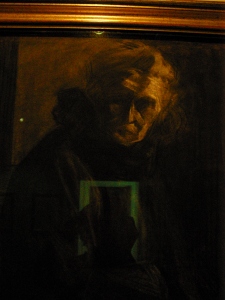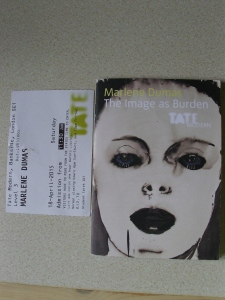I have seen several atmospheric charcoal drawings recently.
In the Thelma Hulbert gallery in Honiton there is a large charcoal by Thelma Hulbert entitled Window, Leaves and Shadow 1952. It is abstract and very dark in places, with etching into the charcoal. Looking at it I could almost hear the leaves moving against the window.
In the Estorik Gallery I saw a drawing by Umberto Boccioni, a large dark, austere drawing in charcoal entitled Seated Woman. The woman’s face and hands are highlighted with white chalk, makes it seem as if she is peering back at her observer.


At the Bristol RWA in the exhibition Drawing On there were two huge charcoals by Carla Grippi of a wooded lane, which drew the viewer down the lane. The artist uses large gestures.
I’m really struggling to find the right words to describe what I saw. I am not familiar enough with words for the techniques used, don’t even know what the work might have entailed, having so little experience myself.
I would welcome help with this, although I have no idea where to get it. the study visit I went on to the Tate Modern (Marlene Dumas) was very little help in this respect.

I visited the print rooms of the Scottish National Gallery in december 2015 and viewed prints from his work The Tempation of St Anthony.
Figure 1.Odilon Redon. (1888) The Tempation of St Anthony.
Odilon Redon was a member of the Symbolist movement of artists. This movement, in the late nineteenth century, grew from the literature of a group of French poets, including Charles Beaudelaire, Stephane Mallarme and Paul Verlaine. It was a reaction against naturalism and realism and the attempts to represent the ordinary as something imbued with greater meaning. Symolists used imagery to represent mystical and religious meaning, rather than representing objects for themselves. In its turn, the symolist movement went on to influence the development of surrealism and expressionism.
The aim of Symbolist art was to be “always ambiguous, indeterminate and subjective”.
Redon’s early work was almost entirely limited to black and white. Examples of his work using lithography can be found online at the Fitzwillian Museum site. He was highly influential in bringing about a revival in the technique of lithography, using the interplay of light and dark tones he produced by this method, to convey deep emotional and spiritual reactions.
A charcoal drawing The Fallen Angel 1872 uses the strong juxtaposition of light and dark on the wings and torso of the crouched angel, to powerfully depict the awesome event, whilst the edges of the work slip away in a subtle ambiguity of shadows, which retains a deep sense of mystery. This is characteristic of his work.

Figure 2. Odilon Redon The Fallen Angel (1872)
In contrast, he uses fine pencil hatching in a drawing entitled Fear 1866, to convey an atmosphere of terror.

Figure 3. Odilon Redon (1865) Fear
The lone horseman, crossing a barren and threatening rocky terrain, is brought to a sudden halt by the fear in his stead, the wind still billowing in his cape. The horizontal rock strata fo the landscape is produced with fine diagonal pencil lines, whilst the vertical fault lines are drawn using closely spaced vertical lines, and depth is portrayed by varying the spacing of the lines and their depth of tone.
Images
Figure 1.Redon, O. (1888) The Temptation of St Anthony. [Lithographs on chine applique] Available at: https://www.nationalgalleries.org/collection/artists-a-z/r/artist/odilon-redon [Accessed on 17/02/2016]
Figure 2. Redon, O. (1872) The Fallen Angel [Charcoal] Available at:https://www.google.co.uk/search?q=the+fallen+angel+odilon+redon&espv=2&biw=1366&bih=610&tbm=isch&imgil=KuDGBrcZcuIoHM%253A%253BHGItxjzHDcEBoM%253Bhttp%25253A%25252F%25252Fwww.wikiart.org%25252Fen%25252Fodilon-redon%25252Ffallen-angel-1872&source=iu&pf=m&fir=KuDGBrcZcuIoHM%253A%252CHGItxjzHDcEBoM%252C_&usg=__KgeLPiZVWemqkUF2H9b44Cjw_ks%3D&ved=0ahUKEwia8_-2tIHLAhWBRBoKHaVFBnsQyjcIJw&ei=5MXFVprxNoGJaaWLmdgH#imgrc=KuDGBrcZcuIoHM%3A [Accessed 17/02/2016]
Figure 3. Redon, O. (1865) Fear [Etching]. Available at:https://www.google.co.uk/search?q=Odilon+redon+fear&espv=2&biw=1366&bih=610&tbm=isch&imgil=e3VAV2eeFgZLuM%253A%253BwhWPKZCIFpjKLM%253Bhttp%25253A%25252F%25252Fxroads.virginia.edu%25252F~museum%25252Farmory%25252FgalleryK%25252Fredon.309.3.html&source=iu&pf=m&fir=e3VAV2eeFgZLuM%253A%252CwhWPKZCIFpjKLM%252C_&usg=__mfKO3GAenyS3qVIad6wVtJbR9Rs%3D&ved=0ahUKEwih5uySuIHLAhXDbxQKHf8SAmgQyjcIJw&ei=ysnFVqHZMsPfUf-liMAG#imgrc=e3VAV2eeFgZLuM%3A. [Accessed: 17/02/2016]








